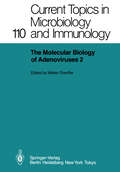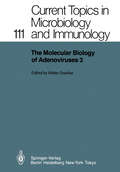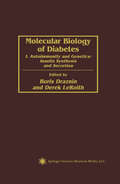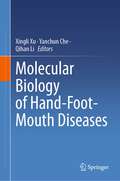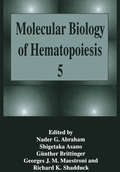- Table View
- List View
Molecular Bioenergetics and Macromolecular Biochemistry: Meyerhof-Symposium Heidelberg, July 5–8, 1970
by Hans H. WeberThe Meyerhof Symposium on "Molecular Bioenergetics and Macromolecular Biochemistry" took place in Heidelberg from the 5th to the 8th of July, 1970. The timing was chosen to coincide with the creation of a new chair, in the Weizmann Institute of Science in Rehovot, in memory of OTTO MEYERHOF and the location was determined by the fact that so much of MEYERHOF'S scientific work was done in Heidelberg. The historical reason for the symposium was the urgent want of many leading biochemists and physiologists active in Molecular Biology to honour the memory of one of the greatest scientists in this field and also one of the greatest biologists of the 20th century. October 1971 is the twentieth anniversary of the death of OTTO MEYERHOF and 1972 marks 50 years since he was awarded the Nobel prize (1922). With regard to the age of some of his friends and pupils it was decided the symposium to be arranged in 1970, the first of the three commemorative years.
Molecular Biology and Evolution of Blood Group and MHC Antigens in Primates
by Antoine Blancher Jan Klein Wladyslaw W. SochaZoologists have categorized primates into a single order, and no one doubts today that they share a common ancestry. Humans and Old and New World non human primate species, from the lemurs of Madagascar to the African anthro poid apes, represent diverging branches of an evolutionary common trunk. Along with species-specific characters, all primates have retained a number of ancestral traits, relics of their common origin. The comparative study of these species-specific and ancestral traits makes it possible to reconstruct the evolu tionary pathways of humans and nonhuman primates. The discovery of the human blood groups and, later, of the Major Histocom patibility Complex (MHC) had a seminal effect on the field of human genetics, providing the first sound examples of mendel ian polymorphisms. The use of blood group and MHC alleles as genetic markers in biological anthropology gen erated a conceptual revolution and persuaded researchers to begin to think in terms of populations and not only intems of typology. The counterparts of these human red and white cell antigens were found and studied in nunhuman primates, and progress in this field is summarized in this book.
Molecular Biology and its Application to Medical Mycology (Nato ASI Subseries H: #69)
by Bruno Maresca George S. Kobayashi Hideyo YamaguchiProceedings of the NATO Advanced Research Workshop on Molecular Biology and its Application to Medical Mycology, held at Taormina, Italy, January 6-8, 1992
Molecular Biology and Pathogenesis of Coronaviruses (Advances in Experimental Medicine and Biology #173)
by P. J. RottierThe present volume contains the Proceedings of an EMBO Workshop organized in June 1983 by the Institute of Virology, Veterinary Faculty, State University of Utrecht, The Netherlands. Some 70 scientists from 11 countries followed the invitation to present and discuss their recent data on the structure, replication, genetics and pathogenesis of coronaviruses. It was the second international meeting on these viruses; the Workshop, which was held in Zeist near Utrecht followed the example of the Wuerzburg symposium of October 1980. At that time it became clear that coronaviruses are unique in many respects. Once a group of viruses that were defined merely on the basis of their characteristic peplomer morphology, Coronaviridae family members are known today - to be constructed from essentially three polypeptides - to use a "nested set" of 5-6 subgenomic mRNAs in the expression of their large, positive and single stranded RNA genome, - to generate these subgenomic RNAs through specific fusion of non contiguous sequences, - to mature by budding from intracellular membranes, - to cause persistent infection with neurological involvement and sometimes immunopathological conditons. These and many other findings have been established only very recently. The articles collected in this book reveal and/or further detail these findings. Since these Proceedings contain the combined scientific presentations of representatives from virtually all laboratories engaged in the field, they provide a fairly comprehensive review of the state of the art in corona virology.
Molecular Biology and Pathogenesis of Peste des Petits Ruminants Virus (SpringerBriefs in Animal Sciences)
by Muhammad Munir Siamak Zohari Mikael BergPeste de Petits Ruminants (PPR) is a highly contagious viral disease of domestic and wild small ruminants that can significantly affect economies. The authors are experts in the field and provide an up-to-date and comprehensive review covering all aspects of the disease. The book is divided into seven chapters highlighting genome organization, virus replication and the determinants of virulence, pathophysiology and clinical disease, immunology and immunopathogenesis, epidemiology, diagnostic assays and vaccines, and the challenges concerning global eradication. It is an invaluable reference work, presenting the latest information for virologists, microbiologists, immunologists, veterinarians, and scientists working in PPR research.
Molecular Biology and Pathogenicity of Mycoplasmas
by Shmuel Razin Richard Herrmannwas the result of the efforts of Robert Cleverdon. The rapidly developing discipline of molecular biology and the rapidly expanding knowledge of the PPLO were brought together at this meeting. In addition to the PPLO specialists, the conference invited Julius Marmur to compare PPLO DNA to DNA of other organisms; David Garfinkel, who was one of the first to develop computer models of metabolism; Cyrus Levinthal to talk about coding; and Henry Quastler to discuss information theory constraints on very small cells. The conference was an announcement of the role of PPLO in the fundamental understanding of molecular biology. Looking back 40-some years to the Connecticut meeting, it was a rather bold enterprise. The meeting was international and inter-disciplinary and began a series of important collaborations with influences resonating down to the present. If I may be allowed a personal remark, it was where I first met Shmuel Razin, who has been a leading figure in the emerging mycoplasma research and a good friend. This present volume is in some ways the fulfillment of the promise of that early meeting. It is an example of the collaborative work of scientists in building an understanding of fundamental aspects of biology.
Molecular Biology of Acute Lung Injury (Molecular & Cellular Biology of Critical Care Medicine #1)
by Hector R. Wong Thomas P. ShanleyAcute lung injury (ALI) impacts patient care in every ICU in the world. Our collective understanding of this condition has grown immensely over the past decade but morbidity and mortality remain unacceptably high. To enhance the understanding of clinicians and researchers, this book addresses the pathophysiology of acute lung injury from a molecular and cellular standpoint; includes animal models of acute lung injury and points to potential therapeutic advances based on scientific findings. It is a concise compendium of the multiple pathways, mechanisms and molecules involved in the pathophysiology of acute lung injury and is intended to help caregivers understand the process and thus care for patients more effectively.
Molecular Biology of Adenoviruses (Virology Monographs Die Virusforschung in Einzeldarstellungen #14)
by L. Philipson U. Pettersson U. LindbergI. Introduction In his biography "Arrow in the Blue" the author Arthur Koestler suggests ironically that the fate of an individual may be predicted by examining the content of the newspapers at birth. Adenoviruses were discovered in 1953 (ROWE et al. , 1953; HILLEMAN and WERNER, 1954). At this time the Salk poliomyelitis vaccine was developed (SALK et al. , 1954) and in the same year the discovery of the double helical structure of DNA (WATSON and CRICK, 1953) and the plaque assay for one animal virus (DULBECCO and VOGT, 1953) was announced. Thus, this new group of viruses was born with great hopes for progress in molecular biology and for the control of animal virus infections. In the short interval be tween 1953 and 1956 the adenoviruses were discovered, methods for laboratory diagnosis and serotyping were established, the epidemiology was clarified and a highly effective vaccine was developed and approved (for a review see HILLE MAN, 1966). Succeeding years showed, however, that the vaccines were contami nated with the oncogenic SV 40 virus and that the adenoviruses themselves were tumorigenic. Since the discovery of adenoviruses animal virology was developed into a quantitative science offering explanation for viral functions at the molecular level. Precise biochemical tools to characterize the genome and its transcription products as well as the structural proteins of these viruses are now available.
The Molecular Biology of Adenoviruses 2: 30 Years of Adenovirus Research 1953–1983 (Current Topics in Microbiology and Immunology #110)
by W. DoerflerThe Molecular Biology of Adenoviruses 3: 30 Years of Adenovirus Research 1953–1983 (Current Topics in Microbiology and Immunology #111)
by W. DoerflerThe Molecular Biology of Adenoviruses I: 30 Years of Adenovirus Research 1953–1983 (Current Topics in Microbiology and Immunology #109)
by W. DoerflerA puzzling epidemiological problem was the driving force behind the discovery of human adenoviruses by Wallace Rowe and his colleagues 30 years ago. The de velopment of a plaque assay for poliomyelitis virus in 1953 led us to the threshold of quantitative virology, and in the same year the double-helical structure of DNA was discovered and became a cornerstone of mo lecular biology. The potential of adenoviruses as research tools in the molecular and cellular biology of eukaryotic cells was recognized as early as the late 1950s and early 1960s by several investigators. Structural and biochemical stu dies dominated the early years. In 1962, some of the adenoviruses were the first human viruses shown to be oncogenic in experimental animals. Thus adenovirology offered the investigator the entire gamut of host cell interactions, productive and abortive, as well as trans formed and tumor cell systems. The possibilities that adenoviruses afforded for the study of the molecular biology and genetics of eukaryotic cells were fully rea lized in the late 1960s and the 1970s.
Molecular Biology of Assemblies and Machines
by Alasdair Steven Wolfgang Baumeister Louise N. Johnson Richard N. PerhamMolecular Biology of Assemblies and Machines provides a comprehensive narrative of the ways in which macromolecular structures assemble and how they interact with other complexes and organelles in the cell. Richly illustrated in full color, the text is written for advanced undergraduates, graduate students, and researchers in biochemistry, molecular biology, biophysics, cell biology, chemistry, structural biology, immunology, microbiology, and medicine.
Molecular Biology of Assemblies and Machines
by Alasdair Steven Wolfgang Baumeister Louise N. Johnson Richard N. PerhamMolecular Biology of Assemblies and Machines provides a comprehensive narrative of the ways in which macromolecular structures assemble and how they interact with other complexes and organelles in the cell. Richly illustrated in full color, the text is written for advanced undergraduates, graduate students, and researchers in biochemistry, molecular biology, biophysics, cell biology, chemistry, structural biology, immunology, microbiology, and medicine.
The Molecular Biology of Autoimmune Disease (Nato ASI Subseries H: #38)
by Andrew G. Demaine J. Paul Banga Alan M. McGregorAutoimmune diseases are common and often associated with considerable morbidity or - in diseases such as IDDM, myasthenia gravis and multiple sclerosis - mortality. In this volume, experts of international stature in basic science and clinical medicine with a common interest in understanding the normal and aberrant immune response present their experiences. It was their intention to fur- ther the understanding of potential clinical application of scientific observations and to help to comprehend the huge amount of results in autoimmunity research.
Molecular Biology of B-Cell and T-Cell Development (Contemporary Immunology)
by John G. MonroeDespite the tremendous diversity of the cells of the hematopoietic system, they are all derived from common precursor cells that are generated in the fetus and persist into adult life. In this regard, Band T lymphocytes, which comprise the two arms of the antigen-specific and inducible immune system, though functionally very different, are descendants of the same stem cell precursor. In the past several years, we have witnessed an explosion of information regarding the process by which differentiation of B-and T-cells from stem cells occurs. This information, like the answers to most important biological questions, has come from multiple and diverse directions. Because all hematopoietic cells arise from common precursors, complex regulatory processes must be involved in determining commitment to various lineages. Understanding commitment to the B- or T-cell lineage remains incomplete; however, identification of transcription factors necessary for progression along specific B-and T-cell pathways suggests that we are on the verge of understanding the molecules involved in the initial fate-determining steps. Studies of this type previously could be accomplished only in nonmammalian systems that are more amenable to genetic approaches. However, new technologies allow increasingly elegant and informative studies in mammalian systems, particularly for cells of the hematopoietic system.
The Molecular Biology of Bacterial Virus Systems (Current Topics in Microbiology and Immunology #136)
by G. Hobom Rudolf RottThe fact that none of the known DNA polymerases is able to initiate DNA chains but only to elongate from a free 3' -OH group raises the problem of how replication is initiated, both at the replication origin and on Okazaki frag ments. It was first shown by A. KORNBERG et al. that a general mechanism to initiate replication is through the formation of an RNA primer catalyzed by RNA polymerases or by a new class of enzymes, the primases (KORNBERG 1980). This mechanism, which can be used in the case of circular DNA molecules or linear DNAs that circularize or form concatemers, cannot be used at the ends of linear DNAs since the RNA primer is removed from the DNA chain, and there is no way of filling the gap resulting at the 5' -ends of the newly synthesized DNA chain. In some cases linear DNA molecules contain a palin dromic nucleotide sequence at the 3' -end that allows the formation of a hairpin structure which provides the needed free 3'-OH group for elongation. This mechanism, first proposed by CAVALIER-SMITH (1974) for eukaryotic DNA repli cation, was shown to take place in several systems (KORNBERG 1980, 1982). Another mechanism to initiate replication consists in the specific nicking of one of the strands of a circular double-stranded DNA, producing a 3'-OH group available for elongation (KORNBERG 1980).
Molecular Biology of Brain and Endocrine Peptidergic Systems (Biochemical Endocrinology)
by Michel Chrétien and Kenneth W. McKernsWe had the pleasure and the great opportunity to organize a symposium on "Molecular Biology of Brain and Endocrine Peptidergic Systems" under the auspices of the Canadian Biochemical society and the International Foundation for Biochemical Endocrinology. We were indeed very happy to ass~ble a series of first rate speakers who delivered excellent papers on a variety of subjects from the synthesis of complicated peptide analogs, to the creation of trangenic mice, site-directed mutagenesis, enzyme characterization and DNA binding sites. One hundred and seventy-five participants attended the 40 conferences while having the opportunity to look at 24 posters presented by senior scientists as well as students. We, of the organizing committee, feel extremely pleased to have received an overwhelming response from such a group of scholars. We wish to express our sincere gratitude to Mrs. Diane Marcil who arranged most aspects of the meeting with efficiency. We also thank the different organizations and companies for their generous grants which made the reunion possible. We hope that the participants have gained scientifically while having a pleasant sojourn in beautiful Montreal. The organizing committee was made up of a group of dedicated people, particularly its secretary, Dr. Philippe Crine. To all speakers and sessions chairpersons, we are indebted for the excellence of their participation.
Molecular Biology of Diabetes: I. Autoimmunity and Genetics; Insulin Synthesis and Secretion
by Boris Draznin Derek LeRoithIn a rapidly evolving and extremely important area of medical science, it is often difficult for the student, teacher, and researcher to keep abreast of all the important advances. The purpose of Molecular Biology ofDiabetes, Parts I and II is to bring to these individuals the latest knowledge of diabetes-related research in a comprehensive, yet concise manner. To this end, we have assembled chapters, written by most of the world's experts in the field, that we believe compre hensively survey and synthesize a coherent understanding of the subject. Studies of the etiology of type I and type II diabetes are extremely exciting and essential, since we hope to one day prevent the disease using gene therapy. These aspects are covered in Molecular Biology of Diabetes: I. Autoimmunity and Genetics; Insulin Synthesis and Secretion. In type II diabetes, an abnormality in pancreatic secretion exists concomitantly with peripheral insulin resistance. This abnor mality of insulin secretion is believed to be related to a defect(s) in glucose sensing. Uncoupling of glucose sensing from insulin secre tion may be the crucial step in the pathogenesis of noninsulin-depen dent diabetes. In this volume, we have invited authors to describe their studies on all known factors affecting ~-cell function, including autoimmunity and genetics of diabetes, as well as molecular mecha nisms of insulin synthesis and secretion. In the last few years, the most rapidly advancing area of research in diabetes has been, in fact, related to insulin action.
Molecular Biology of DNA Methylation (Springer Series in Molecular and Cell Biology)
by Roger L.P. Adams Roy H. BurdonDuring the past few decades we have witnessed an era of remarkable growth in the field of molecular biology. In 1950 very little was known of the chemical constitution of biological systems, the manner in which in formation was transmitted from one organism to another, or the extent to which the chemical basis of life is unified. The picture today is dramati cally different. We have an almost bewildering variety of information detailing many different aspects of life at the molecular level. These great advances have brought with them some breath-taking insights into the molecular mechanisms used by nature for replicating, distributing and modifying biological information. We have learned a great deal about the chemical and physical nature of the macromolecular nucleic acids and proteins, and the manner in which carbohydrates, lipids and smaller mole cules work together to provide the molecular setting of living systems. It might be said that these few decades have replaced a near vacuum of information with a very large surplus. It is in the context of this flood of information that this series of mono graphs on molecular biology has been organized. The idea is to bring together in one place, between the covers of one book, a concise assess ment of the state of the subject in a well-defined field.
The Molecular Biology of Down Syndrome (Journal Of Neural Transmission. Supplementa Ser. #57)
by G. LubecMolecular Biology of Drug Addiction
by Rafael MaldonadoA comprehensive multidisciplinary review of the most relevant molecular, genetic, and behavioral approaches used to investigate the neurobiological basis of drug addiction. The authors explore the latest findings on opioid, psychostimulant, cannabinoid, alcohol, and nicotine addiction, provide fresh insights into the genetic basis of drug addiction and the new therapeutic perspectives these have opened. They describe the technology available to generate conditional knockout mice and show how these mice can reveal the molecular basis of opioid, psychostimulant, and cannabinoid addiction. They also review the different behavioral models available to evaluate the rewarding effects of drugs and analyze the genes involved in alcohol dependence.
Molecular Biology of Erythropoiesis (Advances in Experimental Medicine and Biology #271)
by Joao L. AscensaoThis volume presents the proceedings of the Fourth Annual Symposium on the Molecular Biology of Hemopoiesis, held in Reno, Nevada, November 1 and 2, 1988. Its focus on erythropoiesis represents an attempt to cover a rapidly expanding field, which has gone from elegant studies of erythro poietin physiology, to molecular biology, to clinical applications and again to physiology. The rapid development has been made possible by cloning of erythropoietin gene and the availability of recombinant hormone. The regulation of heme and its derivatives has also been aided by techniques of molecular biology; there is now a concerted effort to better understand how these enzymes contribute to proliferation, differentiation and maturation of the erythron. Globin gene derrangements have been targets of recent research in an attempt to correct the defect by genetic engineering. In the chapters of this book, several groups "expressed" their views on this subject. Finally, we analyze various regulators of erythropoiesis, both in vivo and in vitro. Dr. Richard Levere was a pioneer in many studies of heme metabolism and of erythropoiesis. He has been a generous supporter of research in this field and of our past meetings. It is only. fitting that this volume should be dedicated to him.
Molecular Biology of Hand-Foot-Mouth Diseases
by Xingli Xu Yanchun Che Qihan LiThis book aims to compile the latest scientific information on hand, foot, and mouth disease (HFMD), including its epidemiology, etiology, pathology, immune response and vaccine development. Interestingly, the authors shared their own research experience and offered distinctive insights into the pathogenesis of HFMD and vaccine development. The intended audience, including university researchers, graduate students, and vaccine engineers, is well defined. The book is positioned as a resource that not only presents current knowledge but also has the potential to inspire further research in understanding immune pathogenesis and advancing vaccine development for HFMD.
Molecular Biology of Hematopoiesis 5
by Nader G. Abraham Shigetaka Asano G. Brittinger G. J. M. Maestroni R. K. ShadduckThis volume of Molecular Biology of Hematopoiesis is dedicated to John W. Adam son, M. D. , Tadamitsu Kishimoto, M. D. , Robert C. Gallo, M. D. , Arthur W. Nienhuis, M. D. , and Franco Mandelli, M. D. , for their contributions in developing an overall view of the state-of-the-art knowledge in the field of hematopoiesis. Richard Champlin, among other renowned clinicians, presented updated information on stem cells and T-cell depletion for bone marrow transplant. A clinical update on thrombopoietin was presented by Pamela Hunt of Amgen and by Kenneth Kaushansky. Arthur Nienhuis' and Katherine Turner's contribu tions to our current knowledge and advances in the fields of growth factors and gene transfer were also recognized during the 9th Symposium on Molecular Biology of Hematopoiesis in Genoa. The chapters cover such diverse areas as preclinical and clinical updates on growth factors and positive and negative regulatory molecules. "Advances in Leukemia: Mechanism and Treatment by Interferon" was presented by Professor Sante Tura. Readers will find presentation of exciting advances that have occurred in the area of hematopoiesis. The elucidation of gene structures of key growth factor proteins such as IL-12 and IL-II will lead to new insights and new approaches in understanding the regulation of hematopoiesis, as well as application of new growth factors.









